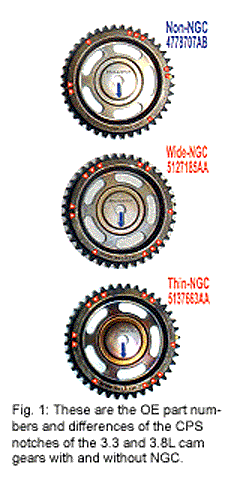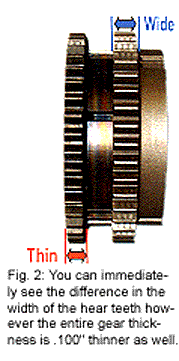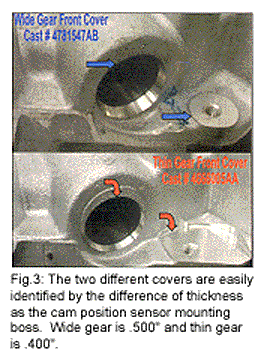Last November’s Core Corner, titled “Understanding Chrysler’s Next Generation Controllers” (November 2005 Engine Builder, page 24) did not include any images of the different cam gears since all you needed to know for identification was that “NGC” was stamped on the gears in question.

Isn’t it always the way when you think that you don’t need something it suddenly turns out that you do? Like throwing away that cylinder head that’s been collecting dust on one of your back shelves for the last 10 years: within a week of discarding it someone shows up looking for that exact piece.
So guess what? Following 2004, Chrysler’s 3.3L and 3.8L engines, are all NGC. But because they are different by about 1/8″, I now need to provide you with pictures. There are also a few subtle changes to the chart included then, so replace that one with the version to the right.
So let’s get down to what you need to know to keep yourself out of trouble with these two different NGC variations. The chart shows that when the 3.3L and 3.8L engines began using NGC in 2004 they used a wide chain measuring approximately .685″ across the links. Then in 01/01/2005 all production began using the new NGC gears and chain that are narrower by approximately 1/8″, with the chain measuring .555″ across the links. This difference can be seen in Figure 1.

Figure 2 shows the notch location for all of the gears w/ and w/o NGC, wide and thin. The red isosceles trapezoids (I knew I would be able to use that term from high school geometry before I died!) with the white centers are located in each of the gears’ trigger notches so you can easily see the differences. As a quick visual reference, if you have one trigger notch in the third of the gear that is being pointed to by the No. 1 cylinder locator it is w/o NGC; if there are four in that same area it is with NGC, whether it is wide or thin.
If you are going to your local Chrysler parts counter the reference is [-XZZ] for non- NGC and [XZZ] with NGC. There is no reference to wide or thin. See Figure 1 for OE part numbers for each of the gears.
So what’s the big deal about a narrow or wide timing chain and gears? Nothing, unless you have a cam position sensor that is in the wrong place and cannot get a correct reading.

But which timing cover goes with which gear set? The first generation wide gear NGC uses timing cover c/n 4781547AB and has a sensor bolt boss area that measures .500″ thick. The second generation thin gear NGC uses timing cover c/n 4666005AA and the sensor bolt boss measures .400″ thick (Figure 3). Other than the casting number and the difference in machining of the sensor location and bolt down, the covers appear to be identical. Both applications do use the same cam position sensor.
So there you have it, short, sweet and simple – but it’s a real quick way to get jammed up if you assemble the wrong cover/gear combinations because the cam position sensor will not read if you do it incorrectly.
For technical questions, contact the Production Engine Remanufacturers Association (PERA) at: [email protected]













